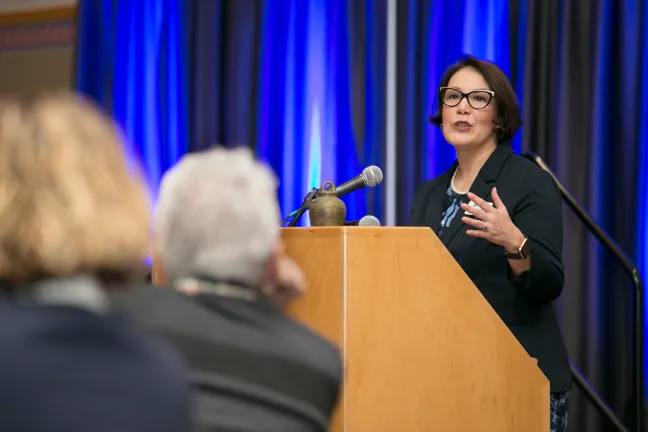The Portland region must plan wisely for growth in order to preserve the natural environment, livability, and quirkiness that makes the area great, Commissioner Jessica Vega Pederson told transportation leaders last week.
Vega Pederson gave the closing remarks at the fourth and final Regional Leadership Forum held to inform the final 2018 Regional Transportation Program on March 2.
With a half a million additional people expected to move into the region by 2040, Vega Pederson said residents are already seeing the impact in increases in rents and housing costs.
“The question we need to ask ourselves is: Can we manage and prepare for that growth while still maintaining what makes our region great? And how do we do it?”
Vega Pederson said the best solution won’t involve expanding major roadways.
“I can pretty reliably tell you the number of communities and neighborhoods that want more traffic going through them: zero.”
But she could also tell the number that want slower speeds, more walkability and safety: “all of them.”
Her own Hazelwood neighborhood in east Portland doesn’t have sidewalks and is half a mile from a bus line. Walking and cycling is clearly dangerous.
She has gone to the vigils: for Morgan Maynard-Cook, who was killed on Division and 136th; for the two people killed on SE Division just hours apart.
Her district is home to two-thirds of the 30 most dangerous intersections in the city according to the Portland Bureau of Transportation’s analysis.
“We have far too many dangerous intersections and roads. It’s for this reason that I won’t let my ten-year old daughter ride her bike to the Midland Library alone, despite it’s close proximity to our house and in the face of her begging and pleading.
The Commissioner said her daughter doesn’t understand why her friends can ride their bikes throughout their neighborhood, but that her parents won’t let her ride in our east Portland neighborhood.
“She doesn’t think it’s fair, and it’s not!’’ Vega Pederson said. “But it doesn’t have to be this way. We can do better, but it has to be intentional. We need to build in the priorities of safety and mobility into our project lists.”
That’s why Vega Pederson said she has asked that all of the Multnomah County projects be reviewed to make sure they include improvements with sufficient crash reduction factors to meet our regionally approved Vision Zero goals.
“We as a region need to be committed to safety.’’
Solutions that protect natural environment, cost less
The Commissioner said that growth will add to congestion bottlenecks that include the I-5 bridge, the Sunset Highway and the Vista Ridge Tunnel, Highway 217 and I-205 around the Abernathy Bridge.
Yet, expanding those bottlenecks would be “ so, so, so expensive” And any steps must speak to the top concerns that people have and “lead with our values around safety, reliability and travel options.” She touted the benefits of congestion pricing, which the region is looking to implement along I-5 and I-205.
She also said the region must build upon the major investments it’s made around light rail and fully expand the system to make the best use of it. These investments, she noted, negate the need for people to own and use cars, reduce pollution, and capitalize on the tracks already laid.
Our region has faced challenges before, Vega Pederson said. “But like the leaders who came before us - who eliminated a highway to make room for a water front park; who fought for farms and forests over subdivisions and sprawl; who said no to another freeway and yes to light rail we can do the right thing and leave a region for our children and grandchildren that we can be proud of.’’

